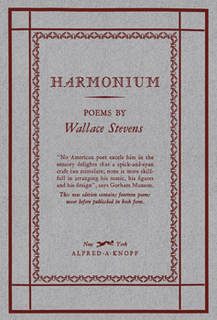Related Research Articles

Harmonium is a book of poetry by American poet Wallace Stevens. His first book at the age of forty-four, it was published in 1923 by Knopf in an edition of 1500 copies. This collection comprises 85 poems, ranging in length from just a few lines to several hundred. Harmonium was reissued in 1931 with three poems omitted and fourteen new poems added.
"The Worms at Heaven's Gate" is a poem from Wallace Stevens' first book of poetry, Harmonium (1923). It was first published in 1916 and is therefore in the public domain.
"The Plot Against the Giant" is a poem from Wallace Stevens's first book of poetry, Harmonium. It was first published in 1917, so it is in the public domain.
"Le Monocle de Mon Oncle" is a poem from Wallace Stevens's first book of poetry, Harmonium. It was first published in 1918.
"Hibiscus on the Sleeping Shores" is a poem from Wallace Stevens's first book of poetry, Harmonium. It was first published in 1921 and is therefore in the public domain.
"From the Misery of Don Joost" is a poem from Wallace Stevens's first book of poetry, Harmonium. It is in the public domain, having been published in the journal Poetry in 1921.
"O Florida, Venereal Soil" is a poem from Wallace Stevens's first book of poetry, Harmonium. It was first published in the journal Dial, volume 73, July 1922, and is therefore in the public domain.
"The Jack-Rabbit" is a poem from Wallace Stevens's first book of poetry, Harmonium (1923).
"The Apostrophe to Vincentine" is a poem from Wallace Stevens's first book of poetry, Harmonium (1923). It was first published before 1923 and is therefore in the public domain according to Librivox.
"Floral Decorations for Bananas" is a poem from Wallace Stevens's first book of poetry, Harmonium (1923). It was first published Measure 26 and is therefore under copyright, however it is quoted here as justified by fair use in order to facilitate scholarly commentary.
"Banal Sojourn" is a poem from Wallace Stevens's first book of poetry, Harmonium. It was originally published in 1919, therefore it is in the public domain.
"Depression Before Spring" is a poem from Wallace Stevens's first book of poetry, Harmonium (1923). It was first published in 1918 and is therefore in the public domain.
"Stars at Tallapoosa" is a poem from Wallace Stevens's first book of poetry, Harmonium. It was first published in 1922, so it is in the public domain.
"Bantams in Pine-Woods" is a poem from Wallace Stevens's first book of poetry, Harmonium. It was first published in 1922 in the poetry journal Dial, along with five other poems, all under the title "Revue". It is in the public domain.
"Cortege for Rosenbloom" is a poem from Wallace Stevens's first book, Harmonium. First published in 1921, it is in the public domain in the United States and similar jurisdictions.
"Tattoo" is a poem from Wallace Stevens's first book of poetry, Harmonium. It was originally published in 1916, so it is in the public domain. Librivox has made the poem available in voice recording in its The Complete Public Domain Poems of Wallace Stevens.
"Two Figures in Dense Violet Light" is a poem from Wallace Stevens's first book of poetry, Harmonium. It was first published in 1923, so it is still under copyright. Only its first stanza is quoted here.
"Hymn From A Watermelon Pavilion" is a poem from Wallace Stevens's first book of poetry, Harmonium. It was first published in 1917, so it is in the public domain.
"The Man Whose Pharynx Was Bad" is a poem from Wallace Stevens's first book of poetry, Harmonium. First published in 1921, it is in the public domain in the United States.
"Tea" is a poem from Wallace Stevens' first book of poetry, Harmonium. It was first published in 1915 in the journal Rogue, so it is in the public domain.
References
- Buttel, R. Wallace Stevens: The Making of Harmonium. 1968: Princeton University Press.
- Bates, Milton. Wallace Stevens: A Mythology of Self. 1985: University of California Press.
- Cook, Eleanor. A Reader's Guide to Wallace Stevens. 2007: Princeton University Press.
- Wilson, Robert A. "A Note on 'Last Looks at the Lilacs'". The Wallace Stevens Journal. Volume 16 Number 2 (Fall 1992)